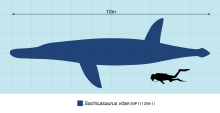| Revision as of 23:02, 19 October 2022 view sourcePaleo17 (talk | contribs)333 edits →Description: Added new size estimation from Paul's new book.Tag: Visual edit← Previous edit | Revision as of 11:18, 1 January 2023 view source 14.49.135.176 (talk) →DescriptionNext edit → | ||
| Line 15: | Line 15: | ||
| == Description == | == Description == | ||
| ] | ] | ||
| The holotype specimen, '''MP111209-1''', is known from a near complete skull, and postcranial elements including a complete hindlimb and various vertebrae. Diagnostic features include a very short mandibular symphysis, reduced number of mandibular teeth (17 to 18 versus 25 to 40 in other pliosaurids),<ref name=Paramo2018_p232>Páramo Fonseca ''et al.'', 2018, p.232</ref> slender teeth, among other features. The specimen has an estimated length of almost {{convert|10|m|ft}}.<ref name=Paramo2018_p224>Páramo Fonseca ''et al.'', 2018, p.224</ref> The specimen is interpreted as a sub-adult individual.<ref name=Paramo2018_p226/> In 2022 ] estimated |
The holotype specimen, '''MP111209-1''', is known from a near complete skull, and postcranial elements including a complete hindlimb and various vertebrae. Diagnostic features include a very short mandibular symphysis, reduced number of mandibular teeth (17 to 18 versus 25 to 40 in other pliosaurids),<ref name=Paramo2018_p232>Páramo Fonseca ''et al.'', 2018, p.232</ref> slender teeth, among other features. The specimen has an estimated length of almost {{convert|10|m|ft}}.<ref name=Paramo2018_p224>Páramo Fonseca ''et al.'', 2018, p.224</ref> The specimen is interpreted as a sub-adult individual.<ref name=Paramo2018_p226/> In 2022 ] estimated its adult size at {{convert|10.8|m|ft}} in length and {{convert|13.5|MT|ST}} in body mass, making it one of the largest pliosaurs.<ref>{{Cite book |last=Paul |first=Gregory S. |title=The Princeton Field Guide to Mesozoic Sea Reptiles |publisher=Princeton University Press |year=2022 |pages=102}}</ref> | ||
| == Paleoenvironment == | == Paleoenvironment == | ||
Revision as of 11:18, 1 January 2023
Extinct genus of pliosaurid
| Sachicasaurus Temporal range: Barremian ~130–120 Ma PreꞒ Ꞓ O S D C P T J K Pg N | |
|---|---|

| |
| Holotype specimen of Sachicasaurus. | |
| Scientific classification | |
| Domain: | Eukaryota |
| Kingdom: | Animalia |
| Phylum: | Chordata |
| Class: | Reptilia |
| Superorder: | †Sauropterygia |
| Order: | †Plesiosauria |
| Family: | †Pliosauridae |
| Subfamily: | †Brachaucheninae |
| Genus: | †Sachicasaurus |
| Species: | †S. vitae |
| Binomial name | |
| †Sachicasaurus vitae Páramo Fonseca et al., 2019 | |
Sachicasaurus is an extinct genus of brachauchenine pliosaurid known from the Barremian of the Paja Formation, Altiplano Cundiboyacense in the Colombian Eastern Ranges of the Andes. The type species is S. vitae.
Etymology
The genus name Sachicasaurus refers to Sáchica, the village where the fossil was found, and saurus, meaning "lizard" in Greek. The species epithet vitae, meaning "life" in Latin, was chosen because of the life in Sáchica the fossil find has sparked.
Description

The holotype specimen, MP111209-1, is known from a near complete skull, and postcranial elements including a complete hindlimb and various vertebrae. Diagnostic features include a very short mandibular symphysis, reduced number of mandibular teeth (17 to 18 versus 25 to 40 in other pliosaurids), slender teeth, among other features. The specimen has an estimated length of almost 10 metres (33 ft). The specimen is interpreted as a sub-adult individual. In 2022 Gregory S. Paul estimated its adult size at 10.8 metres (35 ft) in length and 13.5 metric tons (14.9 short tons) in body mass, making it one of the largest pliosaurs.
Paleoenvironment
Sachicasaurus is one of four pliosaurids from the Paja Formation, others being Acostasaurus, Stenorhynchosaurus, and Monquirasaurus. It is also contemporaneous with the elasmosaurids Callawayasaurus and Leivanectes, the marine turtle Desmatochelys padillai, the sandowniid turtle Leyvachelys, and the ophthalmosaurid ichthyosaurs Muiscasaurus and Kyhytysuka.
References
- Páramo Fonseca et al., 2018, p.225
- ^ Páramo Fonseca et al., 2018, p.226
- Páramo Fonseca et al., 2018, p.232
- Páramo Fonseca et al., 2018, p.224
- Paul, Gregory S. (2022). The Princeton Field Guide to Mesozoic Sea Reptiles. Princeton University Press. p. 102.
- Gómez Pérez & Noè, 2017
- Páramo et al., 2016
- Noè, L.F.; Gómez-Pérez, M. (2021). "Giant pliosaurids (Sauropterygia; Plesiosauria) from the Lower Cretaceous peri-Gondwanan seas of Colombia and Australia". Cretaceous Research. 132: 105122. doi:10.1016/j.cretres.2021.105122.
- Páramo Fonseca et al., 2019
- Cadena et al., 2015a
- Cadena et al., 2015b
- Maxwell et al., 2015
- Cortés, D.; Maxwell, E.E.; Larsson, H.C.E. (2021). "Re-appearance of hypercarnivore ichthyosaurs in the Cretaceous with differentiated dentition: revision of Platypterygius sachicarum (Reptilia:Ichthyosauria, Ophthalmosauridae) from Colombia". Journal of Systematic Palaeontology. 19 (14): 969–1002. doi:10.1080/14772019.2021.1989507. S2CID 244512087.
Bibliography
- Sachicasaurus
- Other paleofauna
- Template:Cite LSA
- Template:Cite LSA
- Template:Cite LSA
- Template:Cite LSA
- Template:Cite LSA
- Template:Cite LSA
| Paleontology in Colombia | |||||||||||||||||||||||||||
|---|---|---|---|---|---|---|---|---|---|---|---|---|---|---|---|---|---|---|---|---|---|---|---|---|---|---|---|
| Notable researchers |
|    | |||||||||||||||||||||||||
| Major fossiliferous stratigraphic units |
| ||||||||||||||||||||||||||
| Notable fossils |
| ||||||||||||||||||||||||||
| Taxon identifiers | |
|---|---|
| Sachicasaurus |
|






